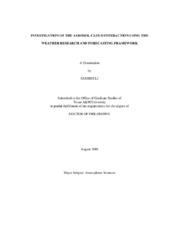| dc.description.abstract | In this dissertation, a two-moment bulk microphysical scheme with aerosol effects is developed and implemented into the Weather Research and Forecasting (WRF) model to investigate the aerosol-cloud interaction. Sensitivities of cloud properties to the representation of aerosol size distributions are first evaluated using a simple box model and a cloud resolving model with a detailed spectral-bin microphysics, indicating that the three-moment method generally exhibits better performance in modeling cloud properties than the two-moment method against the sectional approach. A convective cloud event occurring on August 24, 2000 in Houston, Texas is investigated using the WRF model, and the simulation results are qualitatively in agreement with the measurements. Simulations with various aerosol profiles demonstrate that the response of precipitation to the increase of aerosol concentrations is non-monotonic. The maximal cloud cover, core updraft, and maximal vertical velocity exhibit similar responses as precipitation. The WRF model with the two-moment microphysical scheme successfully simulates the development of a squall line that occurred in the south plains of the U.S. Model experiments varying aerosol concentrations from the clean background case to the polluted continental case show that the aerosol concentrations insignificantly influence the rainfall pattern/distribution, but can remarkably alter the precipitation intensity. The WRF experiment with polluted aerosols predicts 12.8% more precipitation than that with clean aerosols, as well as more intensive rainfall locally. Using the monthly mean cloudiness from the International Satellite Cloud Climatology Project (ISCCP), a trend of increasing deep convective clouds over the north Pacific in winter from 1984 to 2005 is detected. Additionally, through analyzing the results from the Global Precipitation Climatology Project (GPCP) version 2, we also show a trend of increasing wintertime precipitation over the north Pacific from 1984 to 2005. Simulations with the WRF model reveal that the increased deep convective clouds and precipitation are reproduced when accounting for the aerosol effect from the increasing Asian pollution outflow. | en |


